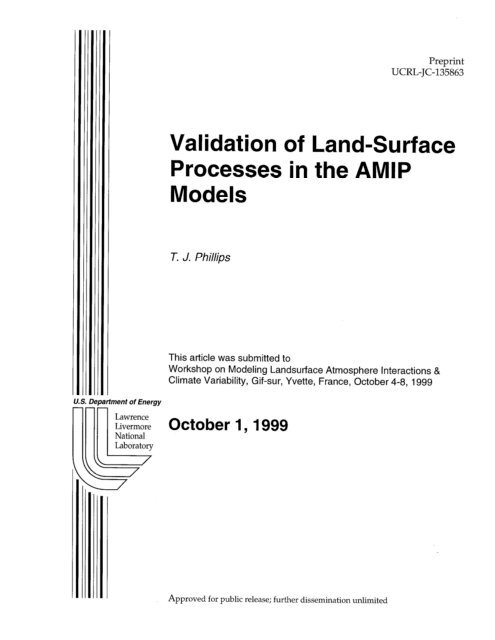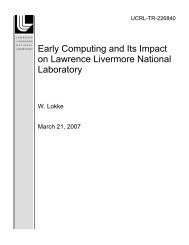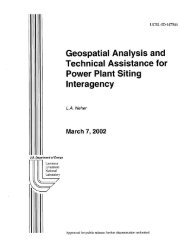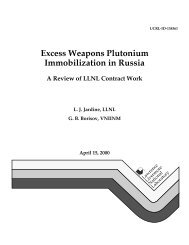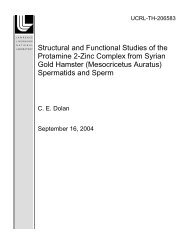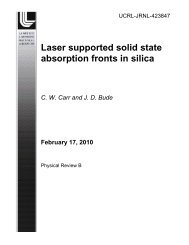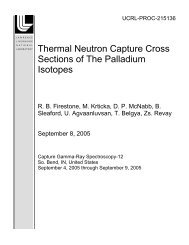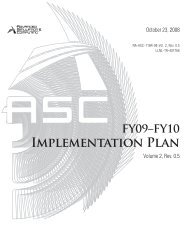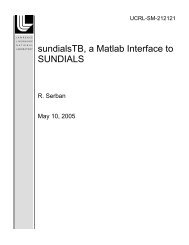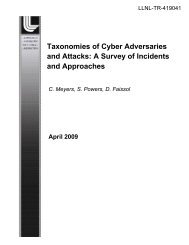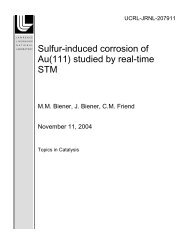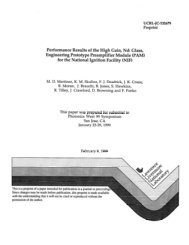Validation of Land-Surface Processes in the AMIP Models
Validation of Land-Surface Processes in the AMIP Models
Validation of Land-Surface Processes in the AMIP Models
You also want an ePaper? Increase the reach of your titles
YUMPU automatically turns print PDFs into web optimized ePapers that Google loves.
U.S. Department <strong>of</strong> Energy<br />
Prepr<strong>in</strong>t<br />
UCRL-JC-135863<br />
<strong>Validation</strong> <strong>of</strong> <strong>Land</strong>-<strong>Surface</strong><br />
<strong>Processes</strong> <strong>in</strong> <strong>the</strong> <strong>AMIP</strong><br />
<strong>Models</strong><br />
T. J. Phillips<br />
This article was submitted to<br />
Workshop on Model<strong>in</strong>g <strong>Land</strong>surface Atmosphere Interactions &<br />
Climate Variability, Gif-sur, Yvette, France, October 4-8, 1999<br />
October I,1999<br />
Approved for public release; fur<strong>the</strong>r dissem<strong>in</strong>ation unlimited
DISCLAIMER<br />
This document was prepared as an account <strong>of</strong> work sponsored by an agency <strong>of</strong> <strong>the</strong> United States<br />
Government. Nei<strong>the</strong>r <strong>the</strong> United States Government nor <strong>the</strong> University <strong>of</strong> California nor any <strong>of</strong> <strong>the</strong>ir<br />
employees, makes any warranty, express or implied, or assumes any legal liability or responsibility for<br />
<strong>the</strong> accuracy, completeness, or usefulness <strong>of</strong> any <strong>in</strong>formation, apparatus, product, or process disclosed, or<br />
represents that its use would not <strong>in</strong>fr<strong>in</strong>ge privately owned rights. Reference here<strong>in</strong> to any specific<br />
commercial product, process, or service by trade name, trademark, manufacturer, or o<strong>the</strong>rwise, does not<br />
necessarily constitute or imply its endorsement, recommendation, or favor<strong>in</strong>g by <strong>the</strong> United States<br />
Government or <strong>the</strong> University <strong>of</strong> California. The views and op<strong>in</strong>ions <strong>of</strong> authors expressed here<strong>in</strong> do not<br />
necessarily state or reflect those <strong>of</strong> <strong>the</strong> United States Government or <strong>the</strong> University <strong>of</strong> California, and<br />
shall not be used for advertis<strong>in</strong>g or product endorsement purposes.<br />
This is a prepr<strong>in</strong>t <strong>of</strong> a paper <strong>in</strong>tended for publication <strong>in</strong> a journal or proceed<strong>in</strong>gs. S<strong>in</strong>ce changes may be<br />
made before publication, this prepr<strong>in</strong>t is made available with <strong>the</strong> understand<strong>in</strong>g that it will not be cited<br />
or reproduced without <strong>the</strong> permission <strong>of</strong> <strong>the</strong> author.<br />
This report has been reproduced<br />
directly from <strong>the</strong> best available copy.<br />
Available to DOE and DOE contractors from <strong>the</strong><br />
Office <strong>of</strong> Scientific and Technical Information<br />
P.O. Box 62, Oak Ridge, TN 37831<br />
Prices available from (423) 5768401<br />
http://apollo.osti.gov/bridge/<br />
Available to <strong>the</strong> public from <strong>the</strong><br />
National Technical Information Service<br />
U.S. Department <strong>of</strong> Commerce<br />
5285 Port Royal Rd.,<br />
Spr<strong>in</strong>gfield, VA 22161<br />
http://www.ntis.gov/<br />
OR<br />
Lawrence Livermore National Laboratory<br />
Technical Information Department’s Digital Library<br />
http://www.Ilnl.gov/tid/Library.html
<strong>Validation</strong> <strong>of</strong> <strong>Land</strong>-<strong>Surface</strong> <strong>Processes</strong> <strong>in</strong> <strong>the</strong> <strong>AMIP</strong> <strong>Models</strong><br />
Thomas J. Phillips<br />
Program for Climate Model Diagnosis and Intercomparison (PCMDI)<br />
Lawrence Livermore National Laboratory<br />
Livermore, California 9455 1 USA<br />
Telephone: +l-925-422-0072<br />
Fax: +l-925-422-7675<br />
E-mail: phillips 14 @ llnl.gov<br />
1. Introduction<br />
The Atmospheric Model Intercomparison Project (<strong>AMIP</strong>) is a commonly accepted protocol for<br />
test<strong>in</strong>g <strong>the</strong> performance <strong>of</strong> <strong>the</strong> world’s atmospheric general circulation models (AGCMs) under com-<br />
mon specifications <strong>of</strong> radiative forc<strong>in</strong>gs (<strong>in</strong> solar constant and carbon dioxide concentration) and ob-<br />
served ocean boundary conditions (Gates 1992, Gates et al. 1999). From <strong>the</strong> standpo<strong>in</strong>t <strong>of</strong> landsurface<br />
specialists, <strong>the</strong> <strong>AMIP</strong> affords an opportunity to <strong>in</strong>vestigate <strong>the</strong> behaviors <strong>of</strong> a wide variety <strong>of</strong> land-<br />
surface schemes (I+!%) that are coupled to <strong>the</strong>ir “native” AGCMs (Phillips et al. 1995, Phillips 1999).<br />
In pr<strong>in</strong>ciple, <strong>the</strong>refore, <strong>the</strong> <strong>AMIP</strong> permits consideration <strong>of</strong> an overarch<strong>in</strong>g question: “To what extent<br />
does an AGCM’s performance <strong>in</strong> simulat<strong>in</strong>g cont<strong>in</strong>ental climate depend on <strong>the</strong> representations <strong>of</strong><br />
land-surface processes by <strong>the</strong> embedded LSS?”<br />
There are, <strong>of</strong> course, some formidable obstacles to satisfactorily address<strong>in</strong>g this question. First,<br />
<strong>the</strong>re is <strong>the</strong> dilemna <strong>of</strong> how to effectively validate simulation performance, given <strong>the</strong> present dearth <strong>of</strong><br />
global land-surface data sets. Even if this data problem were to be alleviated, some <strong>in</strong>herent<br />
methodological difficulties would rema<strong>in</strong>: <strong>in</strong> <strong>the</strong> context <strong>of</strong> <strong>the</strong>-<strong>AMIP</strong>, it is not possible to validate a<br />
given LSS per se, s<strong>in</strong>ce <strong>the</strong> associated land-surface climate simulation is a product <strong>of</strong> <strong>the</strong> coupled<br />
AGCiWLSS system. Moreover, aside from <strong>the</strong> <strong>in</strong>tr<strong>in</strong>sic differences <strong>in</strong> LSS across <strong>the</strong> <strong>AMIP</strong> models,<br />
<strong>the</strong> varied representations <strong>of</strong> land-surface characteristics (e.g. vegetation properties, surface albedos<br />
and roughnesses, etc.) and related variations <strong>in</strong> land-surface forc<strong>in</strong>gs fur<strong>the</strong>r complicate such an<br />
attribution process. Never<strong>the</strong>less, it may be possible to develop validation methodologies/statistics that<br />
are sufficiently penetrat<strong>in</strong>g to reveal “signatures” <strong>of</strong> particular ISS representations (e.g. “bucket” vs<br />
more complex parameterizations <strong>of</strong> hydrology) <strong>in</strong> <strong>the</strong> <strong>AMIP</strong> land-surface simulations.<br />
2. <strong>AMIP</strong> I Versus <strong>AMIP</strong> II<br />
The first phase <strong>of</strong> <strong>the</strong> <strong>AMIP</strong>, designated <strong>AMIP</strong> I, spanned <strong>the</strong> years 1990 to 1996. Among<br />
several efforts to analyze various aspects <strong>of</strong> <strong>the</strong> land-surface climate <strong>of</strong> <strong>the</strong> <strong>AMIP</strong>I models (e.g. Lau<br />
et al. 1996, Frei and Rob<strong>in</strong>son 1998, Robock et al. 1998), <strong>the</strong> GEWEX-<strong>in</strong>itiated Project for<br />
Intercomparison <strong>of</strong> <strong>Land</strong>-surface Parameterization Schemes (PIUS) also contributed (Henderson-<br />
Sellers et al. 1996). In this <strong>AMIP</strong> study, PILPS participants organized as Diagnostic Subproject 12<br />
on <strong>Land</strong>-surface <strong>Processes</strong> and Parameterizations.<br />
Subproject 12 performed its work <strong>in</strong> <strong>the</strong> context <strong>of</strong> several significant limitations: little global<br />
data were available for validation; <strong>the</strong> set <strong>of</strong> model “standard output” variables was quite limited (e.g.,<br />
run<strong>of</strong>f was not provided); and <strong>the</strong>re was a narrow range <strong>of</strong> LSS complexity represented, s<strong>in</strong>ce a large<br />
majority <strong>of</strong> <strong>AMIP</strong> I models used various forms <strong>of</strong> bucket schemes. In this context, Subproject 12<br />
performed a “zeroth-order” land-surface validation, <strong>in</strong> <strong>the</strong> sense <strong>of</strong> identify<strong>in</strong>g discrepancies that<br />
could be readily found from <strong>in</strong>spection <strong>of</strong> <strong>the</strong> <strong>AMIP</strong> I simulations. The ma<strong>in</strong> f<strong>in</strong>d<strong>in</strong>gs were threefold:
1) Every simulation <strong>of</strong> land-surface climate was an outlier <strong>in</strong> some respects, i.e. <strong>the</strong>re was no one<br />
“best” model (Love and Henderson-Sellers 1994).<br />
2) A number <strong>of</strong> simulations exhibited obvious flaws <strong>of</strong> execution such as nonconservation <strong>of</strong> soil<br />
moisture/energy and pronounced trends <strong>in</strong> cont<strong>in</strong>ental moisture stores due to <strong>in</strong>adequate model<br />
<strong>in</strong>itialization/sp<strong>in</strong>-up (Love et al. 1995).<br />
3) Contrary to expectation, <strong>the</strong> <strong>in</strong>ter-model scatter <strong>in</strong> regional-scale energy/moisture partition<strong>in</strong>gs<br />
was substantially larger than <strong>in</strong> comparable PILPS <strong>of</strong>fl<strong>in</strong>e experiments--possibly as a consequence<br />
<strong>of</strong> different regional forc<strong>in</strong>gs <strong>in</strong> <strong>AMIP</strong> I models (Irannejad et al. 1995).<br />
In <strong>the</strong> current AMP II phase <strong>of</strong> <strong>the</strong> <strong>in</strong>tercomparison, <strong>the</strong> experimental design rema<strong>in</strong>s<br />
fundamentally <strong>the</strong> same (i.e. commonly specified radiative forc<strong>in</strong>gs and ocean boundary conditions),<br />
but longer simulations (<strong>of</strong> length 17 years vs 10 years <strong>in</strong> <strong>AMIP</strong> I) are be<strong>in</strong>g run. There also are several<br />
ref<strong>in</strong>ements <strong>of</strong> <strong>the</strong> experimental protocol that address concerns expressed by land-surface specialists<br />
<strong>in</strong> <strong>AMIP</strong> I. These <strong>in</strong>clude a greater emphasis on ensur<strong>in</strong>g adequate <strong>in</strong>itialization/sp<strong>in</strong>-up <strong>of</strong><br />
cont<strong>in</strong>ental moisture stores and conservation <strong>of</strong> energy/moisture; a broader representation <strong>of</strong> different<br />
types/complexities <strong>of</strong> LSS; and a more extensive set <strong>of</strong> required land-surface output variables (see<br />
Table). To date (October 1999), about 20 models have completed <strong>the</strong>ir <strong>AMIP</strong> II simulations, but<br />
model output data have only just been released to <strong>the</strong> diagnostic subprojects.<br />
Table: <strong>AMIP</strong> II Standard Model Output for <strong>Surface</strong> Variables (Ref: Gleckler 1996)<br />
Required Monthly Mean Variables<br />
Ground, screen temperatures<br />
<strong>Surface</strong> and mean sea-level pressure<br />
U-V w<strong>in</strong>ds and stresses<br />
Specific humidity<br />
Evaporation + sublim<strong>in</strong>ation<br />
Up/down shortwave/longwave radiative fluxes<br />
Latent and sensible heat fluxes<br />
Convective and total precipitation rates<br />
Snowfall: rate, depth, cover, melt<br />
lo-cm depth, total soil moisture<br />
<strong>Surface</strong>, total run<strong>of</strong>f<br />
Required Six-Hourly Data<br />
Total precipitation rate<br />
Mean sea-level pressure<br />
Optional Six-Hourly Data<br />
Screen temperature<br />
<strong>Surface</strong> pressure<br />
U-V w<strong>in</strong>ds/stresses<br />
Specific humidity<br />
Up/down shortwave/lon,owave radiative fluxes<br />
Latent and sensible heat fluxes<br />
Snow depth<br />
Total run<strong>of</strong>f, soil moisture<br />
Given <strong>the</strong> richer set <strong>of</strong> model land-surface variables <strong>in</strong> AMlF II, <strong>the</strong>re is a commensurate<br />
demand for validation reference data. Concretely, <strong>the</strong>re is a need for global, gridded data sets that<br />
span at least a decade with<strong>in</strong> <strong>the</strong> <strong>AMIP</strong> II simulation period (from 1979 to 1995). The reality,<br />
however, is that many cont<strong>in</strong>ental variables are not directly measurable at global scale, and <strong>the</strong>re are<br />
mostly only a few years <strong>of</strong> data available from extant global remote-sens<strong>in</strong>g <strong>in</strong>itiatives. Until this data<br />
situation qualitatively improves, validation <strong>of</strong> <strong>the</strong> <strong>AMIP</strong> II models will need to rely heavily on<br />
model-derived estimates <strong>of</strong> land-surface variables such as are provided by various reanalyses, which<br />
conveniently span <strong>the</strong> entire <strong>AMIP</strong> II simulation period. (It should be noted that remotely sensed data<br />
are also model-derived, <strong>in</strong> <strong>the</strong> sense that algorithms must be used to translate <strong>the</strong> observed irradiances<br />
to <strong>the</strong> actual variables <strong>of</strong> <strong>in</strong>terest.)<br />
-2-
Because <strong>the</strong> reanalyses are known to be problematical for land-surface validation at regional<br />
scales (e.g. Betts et al. 1998), Diagnostic Subproject 12 will use <strong>the</strong>se products only for large-scale<br />
validation <strong>of</strong> <strong>the</strong> <strong>AMIP</strong> II models, and will supplement this evaluation with alternative observational<br />
reference data sets, to <strong>the</strong> extent <strong>the</strong>se are available for subperiods <strong>of</strong> <strong>the</strong> simulations (Phillips et al.<br />
1998). In carry<strong>in</strong>g out this validation exercise, Subproject 12 will emphasize land-surface “response”<br />
variables (e.g. evaporation, run<strong>of</strong>f, turbulent fluxes, etc.), view<strong>in</strong>g <strong>the</strong> evaluation <strong>of</strong> “forc<strong>in</strong>g”<br />
variables (e.g. precipitation, radiative fluxes, momentum stresses) ma<strong>in</strong>ly <strong>in</strong> <strong>the</strong> context <strong>of</strong><br />
<strong>in</strong>terpret<strong>in</strong>g this “response”. (It is recognized, <strong>of</strong> course, that “forc<strong>in</strong>g” and “response” are not cleanly<br />
separable <strong>in</strong> a coupled AGCM/LSS. ) Fur<strong>the</strong>r details <strong>of</strong> <strong>the</strong> planned validation methodology are<br />
discussed <strong>in</strong> <strong>the</strong> next section.<br />
3. A <strong>Validation</strong> Methodology: Examples from <strong>AMIP</strong> I <strong>Models</strong><br />
In this section, <strong>the</strong> outl<strong>in</strong>es <strong>of</strong> a validation methodology that is relevant for <strong>AMIP</strong> II are<br />
sketched and illustrated by application to selected land-surface variables <strong>in</strong> <strong>the</strong> <strong>AMIP</strong> I models. It is<br />
anticipated that as <strong>the</strong> validation <strong>of</strong> <strong>AMIP</strong> II models proceeds, this methodology both will be<br />
extended and ref<strong>in</strong>ed.<br />
In an <strong>in</strong>tercomparison experiment as ambitious as <strong>AMIP</strong> II (30+ models, 17 year-simulations,<br />
- 20 land-surface variables), <strong>the</strong> calculation <strong>of</strong> summary statistics is essential for a practical<br />
validation effort. For each variable <strong>of</strong> <strong>in</strong>terest, comparison <strong>of</strong> <strong>the</strong> annual-mean, global-mean<br />
climatology, or <strong>the</strong> “bias” -CM> <strong>of</strong> a model, with that <strong>of</strong> an appropriate observational reference CO><br />
is a natural first step <strong>in</strong> <strong>the</strong> validation process. Thereafter, it is more challeng<strong>in</strong>g to concisely<br />
summarize <strong>the</strong> model’s spatio-temporal variation about its bias, { M(x,y,t) - &I>}, <strong>in</strong> relation to <strong>the</strong><br />
correspond<strong>in</strong>g reference variation, { O(x,y,t) - -CO>}, when t - 200 months as <strong>in</strong> <strong>AMIP</strong>II.<br />
As a start<strong>in</strong>g po<strong>in</strong>t for such a validation exercise, it is useful to def<strong>in</strong>e a normalized spatio-<br />
temporal RMS error E/o0 where<br />
E=<br />
and<br />
is <strong>the</strong> spat6temporal standard deviation <strong>of</strong> <strong>the</strong> observational reference about its bias. The normalized RMS<br />
error El&is a dimensionless statistic that can be used to consistently compare <strong>the</strong> performance <strong>of</strong> amodel across<br />
different variables (hav<strong>in</strong>g different Go).<br />
O<strong>the</strong>r statistical measures <strong>of</strong> “goodness-<strong>of</strong>-fit” are also useuI <strong>in</strong> this context. For example, <strong>the</strong> normalized<br />
RMS error may be viewed as consist<strong>in</strong>g <strong>of</strong> errors <strong>in</strong> “amplitude” and “pattern”. The amplitude error can be<br />
expressed by <strong>the</strong> deviation <strong>of</strong> o,/oo. from unity, where <strong>the</strong> spatio-temporal standard deviation obt <strong>of</strong> <strong>the</strong> model<br />
is def<strong>in</strong>ed analogously to o. above. The pattern error can be captured by <strong>the</strong> deviation from unity <strong>of</strong> a spatiotemporal<br />
correlation statistic<br />
It can be shown that <strong>the</strong>se three statistics share a law-<strong>of</strong>-cos<strong>in</strong>es relationship, so that <strong>the</strong>y may be simultaneously<br />
represented <strong>in</strong> a two-dimensional polar plot (K. Taylor, unpublished manuscript). An example <strong>of</strong> such<br />
-3-
a ‘Taylor diagram” for <strong>the</strong> land-surface temperature <strong>of</strong> - 30 <strong>AMIP</strong> I models (e.g. designated by acronyms<br />
“DNM”, “UP”, etc.) is shown <strong>in</strong> Figure 1. Here <strong>the</strong> label “Observed” on <strong>the</strong> abscissa <strong>in</strong>dicates <strong>the</strong> reference<br />
po<strong>in</strong>t, which <strong>in</strong> this case is <strong>the</strong> land-surface tempx&um estimated from <strong>the</strong> NCEP/NCAR Reanalysis (Kalnay<br />
et al. 1996) for <strong>the</strong> period <strong>of</strong> <strong>the</strong> de&al (1979-1988) <strong>AMIP</strong> I simulation. (The NCEP reanalysis model used<br />
radiative forc<strong>in</strong>gs and ocean boundary conditions very similar to those <strong>of</strong> <strong>the</strong> <strong>AMIP</strong> I models.) The radial dimension<br />
<strong>of</strong> <strong>the</strong> polar plot is proportional to <strong>the</strong> amplitude ratio oM/oo (where a value <strong>of</strong> unity is <strong>in</strong>dicated by <strong>the</strong><br />
dotted l<strong>in</strong>e), while <strong>the</strong> angular dimension is scaled proportional to <strong>the</strong> cos<strong>in</strong>e <strong>of</strong> <strong>the</strong> spatio-temporal pattern correlation<br />
R. F<strong>in</strong>ally, <strong>the</strong> distance between <strong>the</strong> temperature <strong>of</strong> <strong>the</strong> observational reference po<strong>in</strong>t (“Observed” ) and<br />
that <strong>of</strong> a given model (“DNM?’ etc.) is <strong>in</strong>dicative <strong>of</strong> <strong>the</strong> model’s normalized R&IS error E/00. It is seen that, collectively,<br />
<strong>the</strong> land-surface temperature <strong>of</strong> <strong>the</strong> <strong>AMIP</strong> I models matches <strong>the</strong> observational reference quite well,<br />
with amplitude ratio GM / Go - 1, pattern correlation R > 0.95, and correspond<strong>in</strong>gly small normalized<br />
RMS error E/oo.<br />
A qualitatively different assessment obta<strong>in</strong>s for <strong>the</strong> simulations <strong>of</strong> land-surface precipitation by <strong>the</strong> <strong>AMIP</strong><br />
I models (Figure 2). Here <strong>the</strong> amplitude ratios range between - 0.6-2.0 (with correspond<strong>in</strong>gly large scatter <strong>in</strong><br />
<strong>the</strong> normalized RMS errors), while <strong>the</strong> pattern correlations are only - 0.5-0.6 for most <strong>of</strong> <strong>the</strong> models. The<br />
AMLP I simulations <strong>of</strong> land-surface evaporation (Figure 3) occupy an <strong>in</strong>termediate position with<strong>in</strong> <strong>the</strong> performance<br />
bounds demarcated by <strong>the</strong> land-surface precipitation and temperature: <strong>the</strong> amplitude ratios range<br />
between - 0.6 and - 1.3, and <strong>the</strong> pattern correlations between - 0.7 and - 0.9.<br />
Fii 1: A ‘Taylor diagram” for a lo-year time series <strong>of</strong> <strong>the</strong> land-surface temperahne field <strong>in</strong><br />
MTCP I models, plotted with respect to <strong>the</strong> observational reference (designated as “Observed”),<br />
as obta<strong>in</strong>ed f?om <strong>the</strong> NCEP/NCAR ~~~4ysis estimate <strong>of</strong> this variable for <strong>the</strong> same time period.<br />
The radial dimension <strong>of</strong> this polar plot is scaled l<strong>in</strong>early proportional to <strong>the</strong> ratio <strong>of</strong> <strong>the</strong> <strong>in</strong>tegmkd<br />
spatio-tempoml standard deviations <strong>of</strong> each model (designated by acronym) and that <strong>of</strong> <strong>the</strong> observational<br />
reference: ~rvr/o~ (with a ratio <strong>of</strong> unity <strong>in</strong>dicated by <strong>the</strong> dotted l<strong>in</strong>e). The angular dimension is<br />
scaled proportional to <strong>the</strong> cos<strong>in</strong>e <strong>of</strong> <strong>the</strong> <strong>in</strong>tqgated spatio-tempoml pattern correlation R <strong>of</strong> each model<br />
with <strong>the</strong> observational reference. The <strong>in</strong>tegmted normalized RMS error E~TO is proportional to <strong>the</strong><br />
distance between each model and <strong>the</strong> “Observed” po<strong>in</strong>t. ( See text for def<strong>in</strong>itions <strong>of</strong> <strong>the</strong>se statistics.)<br />
<strong>Land</strong>surface Sk<strong>in</strong> Temperature: <strong>AMIP</strong> I <strong>Models</strong> vs NCEP Reanalysis<br />
-4
Figure 2: As <strong>in</strong> Fi.gg 1, except for land-surface precipitation.<br />
<strong>Land</strong>surface Precipitation: <strong>AMIP</strong> I <strong>Models</strong> vs NCEP Reanalysis<br />
Fi,me 3: As <strong>in</strong> Fi,gyre 1, except for land-surface evapomtion.<br />
s<br />
E w<br />
iz<br />
2 0.75 -<br />
‘E s<br />
.4<br />
2<br />
% 0.50 -<br />
-z<br />
L<br />
0.25 -<br />
0.00 -<br />
analysis<br />
<strong>Land</strong>surface Evaporation: <strong>AMIP</strong> I <strong>Models</strong> vs NCEP Reanalysis<br />
total space-time pattern analysis<br />
To some extent, <strong>the</strong> location <strong>of</strong> a land-surface evaporation po<strong>in</strong>t <strong>in</strong> <strong>the</strong> Taylor diagram <strong>of</strong> Figure 3 appears<br />
to depend on <strong>the</strong> respective LSS type (Figure 4), <strong>in</strong> that <strong>the</strong>re is a tendency for most <strong>of</strong> <strong>the</strong> LSS <strong>of</strong> a similar<br />
complexity to cluster <strong>in</strong> <strong>the</strong> same statistical “neighborhood”. Moreover, as a group, LSS with explicit representations<br />
<strong>of</strong> vegetation tend to exhibit lower RI!@ errors with respect to <strong>the</strong> NCFWNCAR reference data than do<br />
simple-bucket LSS, while augmented-bucket LSS tend to show <strong>in</strong>termediate-sized RMS errors. (There are<br />
<strong>in</strong>dividual exceptions to this general tendency, however. For example, a few vegetationcaqopy LSS show<br />
relatively large Rh/ls errors, but <strong>the</strong>se are ma<strong>in</strong>ly associated with errors <strong>of</strong> amplitude ra<strong>the</strong>r than <strong>of</strong> pattern.)<br />
This tendency for surface evaporation to stratify accord<strong>in</strong>g to LSS type is magnified when <strong>the</strong><br />
validation methodology is applied only to a subcomponent <strong>of</strong> <strong>the</strong> total spatio-temporal variability<br />
<strong>of</strong> <strong>the</strong> models, and especially to <strong>the</strong> zonally asymmetric part <strong>of</strong> <strong>the</strong> seasonal cycle (Figure 5). On<br />
-5
<strong>the</strong> o<strong>the</strong>r hand, when only <strong>the</strong> <strong>in</strong>terannual component (a small fraction <strong>of</strong> total spatio-temporal<br />
variability) <strong>of</strong> surface evaporation is considered, all <strong>the</strong> <strong>AMIP</strong>I models exhibit very high RMS er-<br />
rors with respect to <strong>the</strong> reference data (Figure 6). In general, <strong>the</strong>se are associated with very low<br />
pattern correlations, possibly an irremediable outcome <strong>of</strong> <strong>the</strong> models’ chaotic behavior. A few<br />
models, however, replicate <strong>the</strong> amplitude <strong>of</strong> <strong>the</strong> reference’s <strong>in</strong>terannual component fairly well, but<br />
<strong>in</strong> this respect an obvious relationship to LSS type appears to be absent.<br />
F&n-e 4: As <strong>in</strong> Figure 3, except that <strong>the</strong> LSS type correspond<strong>in</strong>g to each AMP I model is <strong>in</strong>dicated.<br />
1.00 -... . . . .._.._<br />
t<br />
‘Z<br />
s<br />
.m<br />
b<br />
0<br />
0.75 -<br />
<strong>Land</strong>surface Evaporation: <strong>AMIP</strong> I <strong>Models</strong> vs NCEP Reanalysis<br />
total space-time pattern analysis<br />
+ Prescribed Soil Moisture<br />
*I Simple Bucket<br />
o Augmented Bucket<br />
c Vegetation Canopy<br />
Figure 5: As <strong>in</strong> Figure 4, except for <strong>the</strong> zonally asymmetric component <strong>of</strong> <strong>the</strong> climatological<br />
seasonal cycle <strong>of</strong> land-surface evaporation.<br />
1.25-<br />
<strong>Land</strong>surface Evaporation: <strong>AMIP</strong> I <strong>Models</strong> vs NCEP Reanalysis<br />
-6-<br />
e-time pattern analysis<br />
T Prescribed Soil Moisture<br />
I Simple Bucket<br />
o Augmented Bucket<br />
Vegetation Canopy
Figure 6: As <strong>in</strong> Figure 4, except for <strong>the</strong> <strong>in</strong>terannual departures from <strong>the</strong> climatology <strong>of</strong><br />
land-surface evaporation.<br />
<strong>Land</strong>surface Evaporation: <strong>AMIP</strong> I <strong>Models</strong> vs NCEP Reanalysis<br />
analysis<br />
Figure 7: As <strong>in</strong> Figwe 4, except for tw<strong>in</strong> AMP I simulations <strong>of</strong> land-surface evaporation by <strong>the</strong> LNJD<br />
AGCM with embedded simple-bucket and biophysically based SECHIBA schemes.<br />
<strong>Land</strong>surface Evaporation: LMD <strong>Models</strong> vs NCEP Reanalysis<br />
x LMD-Simple Bucket<br />
Q LMD-SECHIBA<br />
In addition, <strong>the</strong>re are many o<strong>the</strong>r parameterization differences among <strong>the</strong> <strong>AMIP</strong> I models, so<br />
that <strong>the</strong> apparent stratification <strong>of</strong> surface evaporation accord<strong>in</strong>g to LSS type may be merely co<strong>in</strong>-<br />
cidental. However, a few <strong>AMIP</strong> I simulations where <strong>the</strong> same atmospheric model was coupled to<br />
different LSS can provide some prelim<strong>in</strong>ary answers to this question. For example, tw<strong>in</strong> <strong>AMIP</strong> I<br />
experiments were run with <strong>the</strong> LMD model, <strong>the</strong> first simulaton with a simple bucket scheme<br />
(Laval et al. 198 l), and <strong>the</strong> second with <strong>the</strong> biophysically based SECHIBA scheme (Ducoudre et<br />
al. 1993). In both simulations, <strong>the</strong> surface characteristics (vegetation, albedos, surface<br />
-7-
oughnesses) rema<strong>in</strong>ed <strong>the</strong> same, so that only <strong>the</strong> effects <strong>of</strong> “<strong>in</strong>tr<strong>in</strong>sic” LSS differences were<br />
manifested. The relevant Taylor diagram for surface evaporation is shown <strong>in</strong> Figure 7, with <strong>the</strong> <strong>the</strong><br />
NCEP/NCAR Reanalysis aga<strong>in</strong> serv<strong>in</strong>g as a validation reference. It is seen that virtually no change<br />
<strong>in</strong> pattern correlation results from vary<strong>in</strong>g <strong>the</strong> LSS, but <strong>the</strong>re are discernable improvements <strong>in</strong> <strong>the</strong><br />
amplitude <strong>of</strong> <strong>the</strong> total spatio-temporal variability <strong>of</strong> surface evaporation. A similar improvement is<br />
seen <strong>in</strong> <strong>the</strong> amplitude <strong>of</strong> <strong>the</strong> <strong>in</strong>terannual component <strong>of</strong> this variability (Figure 8).<br />
Figure 8: As <strong>in</strong> Figure 7, except for <strong>the</strong> <strong>in</strong>terannual departures from <strong>the</strong> climatology <strong>of</strong><br />
land-surface evaporation.<br />
‘4. Initial Conclusions and Future Directions<br />
<strong>Land</strong>surface Evaporation: LMD <strong>Models</strong> vs NCEP Reanalysis<br />
ZL LMD-Simple Bucket<br />
u LMD-SECHIBA<br />
The follow<strong>in</strong>g <strong>in</strong>itial conclusions can be drawn from this validation exercise :<br />
l The assessment <strong>of</strong> model performance <strong>in</strong> simulat<strong>in</strong>g cont<strong>in</strong>ental climate is colored by <strong>the</strong><br />
choice <strong>of</strong> land-surface variables for validation. For example, <strong>the</strong> <strong>AMIP</strong> I models collective-<br />
ly simulate land-surface temperature much better than precipitation.<br />
l At global scale, <strong>the</strong> spatio-temporal variability <strong>of</strong> land-surface evaporation appears to be<br />
sensitive to <strong>the</strong> LSS type.<br />
l When operated <strong>in</strong> coupled mode, simple-bucket LSS calz produce simulations <strong>of</strong> <strong>the</strong> spatio-<br />
temporal variability <strong>of</strong> surface evaporation that are “competitive” with those obta<strong>in</strong>ed from<br />
AGCMs with more complex LSS. However, for <strong>the</strong> same AGCM, <strong>the</strong> replacement <strong>of</strong> a<br />
simple bucket scheme by a biophysically based LSS may globally improve some aspects<br />
(e.g. reduction <strong>of</strong> amplitude errors) <strong>of</strong> <strong>the</strong> simulation <strong>of</strong> surface evaporation variability.<br />
l The simple-bucket schemes seem to have more difficulty simulat<strong>in</strong>g <strong>the</strong> zonally asymmetric<br />
component <strong>of</strong> <strong>the</strong> land-surface evaporation field, when compared with more complex LSS.<br />
However, this may reflect <strong>the</strong> absence <strong>of</strong> explicit vegetation and related surface characteris-<br />
tics (e.g., albedos and surface roughnesses) more than “<strong>in</strong>tr<strong>in</strong>sic” deficiencies <strong>of</strong> <strong>the</strong> simple-<br />
bucket schemes.<br />
-8-
l In general, <strong>the</strong> spatio-temporal pattern <strong>of</strong> <strong>the</strong> <strong>in</strong>terannual component <strong>of</strong> <strong>the</strong> land-surface<br />
evaporation is poorly simulated (possibly due to <strong>the</strong> models’ chaotic behavior), but a few<br />
<strong>AMIP</strong> I models are better able to replicate its amplitude. In <strong>the</strong> latter respect, however, <strong>the</strong>re<br />
does not appear to be an obvious relationship to LSS type.<br />
Because <strong>of</strong> <strong>the</strong> limited scope <strong>of</strong> this validation exercise, <strong>the</strong>se conclusions must be regarded<br />
as quite prelim<strong>in</strong>ary. In particular, <strong>the</strong>y may depend on <strong>the</strong> peculiarities <strong>of</strong> <strong>the</strong> NCEZP/NCAR<br />
Reanalysis that were used as a validation reference. At this po<strong>in</strong>t, <strong>the</strong>refore, <strong>the</strong>se conclusions<br />
should be viewed as work<strong>in</strong>g hypo<strong>the</strong>ses to guide <strong>the</strong> work <strong>of</strong> Subproject 12 <strong>in</strong> <strong>AMIP</strong>II. A similar<br />
methodology will be employed, for example, to evaluate whe<strong>the</strong>r <strong>the</strong>re has been a change <strong>in</strong> performance<br />
<strong>in</strong> <strong>the</strong> simulation <strong>of</strong> land-surface climate result<strong>in</strong>g from parameterization changes <strong>in</strong><br />
<strong>AMIP</strong> I vs <strong>AMIP</strong> II versions <strong>of</strong> a model. In addition, future directions that also seem worth<br />
explor<strong>in</strong>g <strong>in</strong>clude:<br />
l Use <strong>of</strong> o<strong>the</strong>r reanalyses (e.g. those <strong>of</strong> <strong>the</strong> ECMWF’ and NASA) and remote-sens<strong>in</strong>g data sets<br />
as alternative validation references.<br />
l Application <strong>of</strong> this methodology to cont<strong>in</strong>ental-scale variability.<br />
l Investigation <strong>of</strong> <strong>the</strong> utility <strong>of</strong> o<strong>the</strong>r validation summary statistics.<br />
l Assessment <strong>of</strong> <strong>the</strong> relative weight <strong>of</strong> land-surface characteristics vs LSS parameterizations<br />
<strong>in</strong> determ<strong>in</strong><strong>in</strong>g <strong>the</strong> coupled simulation <strong>of</strong> cont<strong>in</strong>ental climate (possibly realized by means <strong>of</strong><br />
a future <strong>AMIP</strong> II experimental subproject).<br />
Acknowledgments<br />
The validation methodology and related computer s<strong>of</strong>tware applied here<strong>in</strong> to <strong>AMIP</strong> landsurface<br />
variables were developed by PCMDI scientists Karl Taylor and Charles Doutriaux. Their<br />
assistance <strong>in</strong> <strong>the</strong> production <strong>of</strong> <strong>the</strong> displayed figures also is gratefully acknowledged. This work was<br />
performed under <strong>the</strong> auspices <strong>of</strong> <strong>the</strong> Department <strong>of</strong> Energy Environmental Sciences Division by <strong>the</strong><br />
Lawrence Livermore National Laboratory under Contract W-7405ENG-48.<br />
-9-
References<br />
Betts, A.K., P. Viterbo, and E. Wood, 1998: <strong>Surface</strong> energy and water balance for <strong>the</strong> Arkansas-<br />
Red River bas<strong>in</strong> from <strong>the</strong> ECMWF reanalysis. J. Climate, 11,2881-2897.<br />
Ducoudre, N., K. Laval, and A. Perrier, 1993: SECHIBA, a new set <strong>of</strong> parameterizations <strong>of</strong> <strong>the</strong><br />
hydrologic exchanges at <strong>the</strong> land/atmosphere <strong>in</strong>terface with<strong>in</strong> <strong>the</strong> LMD atmospheric general cir-<br />
culation model. J. Climate, 6,248-273.<br />
Frei, A., and D. Rob<strong>in</strong>son, 1998: Evaluation <strong>of</strong> snow extent and its variability <strong>in</strong> <strong>the</strong> Atmospheric<br />
Model Intercomparison Project. J. Geophys. Res., 103,8859-887 1.<br />
Gates, W.L., 1992: <strong>AMIP</strong>: The Atmospheric Model Intercomparison Project. Bull. Amer. Meteor.<br />
Sot., 73, 1962-1970.<br />
Gates, W.L. and Coauthors, 1999: An overview <strong>of</strong> <strong>the</strong> results <strong>of</strong> <strong>the</strong> Atmospheric Model Intercom-<br />
parison Project (<strong>AMIP</strong>I). Bull. Amer. Meteor. Sot., 80,29-55.<br />
Gleckler, P.J., 1996: <strong>AMIP</strong> II Guidel<strong>in</strong>es. <strong>AMIP</strong> Newsletter No. 8, accessible onl<strong>in</strong>e at http://<br />
www-pcmdi.llnl.gov/amip/NEWS/amipnl8.html.<br />
Henderson-Sellers, A., K. McGuffie, and A.J. Pitman, 1996: The Project for <strong>the</strong> Intercomparison<br />
<strong>of</strong> <strong>Land</strong>-surface Parameterization Schemes: 1992-1995. Climate Dyn., 12, 849-859.<br />
Kalnay, E. and Coauthors, 1996: The NMUNCAR 40-year reanalysis project. Bull. Amer. Meteor.<br />
SOC.) 77,437-47 1.<br />
Lau, W.K.-M., J.H. Kim, and Y. Sud, 1996: Intercomparison <strong>of</strong> hydrologic processes <strong>in</strong> <strong>AMIP</strong><br />
GCMs. Bull. Amer. Meteor. Sot., 77,2209-2226.<br />
Laval, K., R. Sadoumy, and V. Seraf<strong>in</strong>i, 1981: <strong>Land</strong> surface B recesses <strong>in</strong> a simplified general<br />
circulation model. Geophys. Astrophys. Fluid Llyn., 17, 129- 15 .<br />
Phillips, T.J., 1999: <strong>AMIP</strong> II model features documentation. Accessible onl<strong>in</strong>e at http://www-<br />
pcmdi.llnl.gov/modeldoc/ amip2/ .<br />
Phillips, T.J., R. Anderson, and M. Brosius, 1995: Summary documentation <strong>of</strong> <strong>the</strong> <strong>AMIP</strong> I models.<br />
Accessible onl<strong>in</strong>e at http://www-pcmdi.llnl.gov/modeldoc/amip1/ .<br />
Phillips, T.J., A. Henderson-Sellers, A. Hahman, and A.J. Pitman, 1998: <strong>AMIP</strong> II diagnostic<br />
subproject 12: <strong>Land</strong>-surface processes and parameterizations (a jo<strong>in</strong>t <strong>AMIP</strong>/P&PS proJect).<br />
Accessible onl<strong>in</strong>e at http://www-pcmdi.llnl.gov/pilps3/proposal/.<br />
Robock, -A., C.A. Schlosser, K.Ya. V<strong>in</strong>nikov, N.A. Speranskaya, J.K. E%<strong>in</strong>, andS. Qiu, 1998: ’<br />
Evaluation <strong>of</strong> <strong>AMIP</strong> soil moisture simulations. Glob. Plan. Change, 19, 18 l-208.<br />
-lO-


